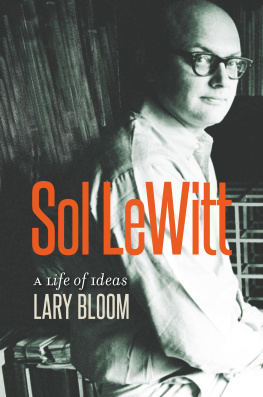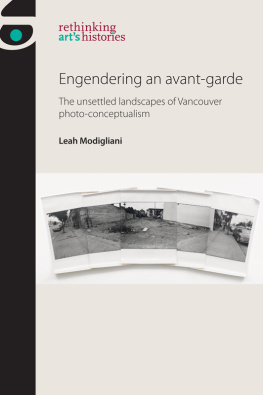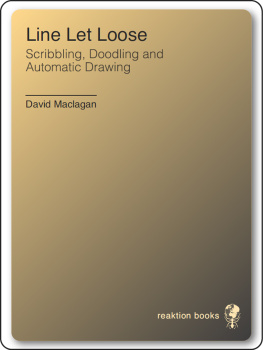
Sol LeWitt
ALSO BY LARY BLOOM
The Writer Within
Lary Blooms Connecticut Notebook
Something Personal
Alone Together
Letters from Nuremberg (with Christopher J. Dodd)
The Test of Our Times (with Tom Ridge)
The Ignorant Maestro (with Itay Talgam)
When the Game is on the Line (with Rick Horrow)
Twains World (editor and contributor)
A Still, Small Voice (contributor)
Conversations with Yusef Komunyakaa (contributor)
The Book That Changed My Life (contributor)
This New England (contributor)
Miles Ahead (with Bill Andresen)
Ensign-Bickford 19362011
A
DRIFTLESS CONNECTICUT
SERIES BOOK
This book is a 2019 selection in the
Driftless Connecticut Series, for an
outstanding book in any field on a
Connecticut topic or written by a
Connecticut author.
Sol LeWitt
A LIFE OF IDEAS
LARY BLOOM
WESLEYAN UNIVERSITY PRESS
Middletown, Connecticut
Wesleyan University Press
Middletown CT 06459
www.wesleyan.edu/wespress
2019 Lary Bloom
All rights reserved
Manufactured in the United States of America
Designed by Rich Hendel
Typeset in Utopia and Owen fonts by
Passumpsic Publishing
The Driftless Connecticut Series is funded by the
Beatrice Fox Auerbach Foundation Fund
at the Hartford Foundation for Public Giving.
Library of Congress Cataloging-in-Publication Data available upon request
Hardcover ISBN: 9780-819578686
Ebook ISBN: 9780-819578709
5 4 3 2 1
Front cover illustration: Sol LeWitt in his Hester Street Studio, August 1969 by Jack Robinson, courtesy of the Hulton Archive and Getty Images.
TO SUZANNE
CONTENTS
INTRODUCTION
In June 2011, four years after Sol LeWitts death, Vanity Fair published a short piece that became a call to biographical action. A photograph showed LeWitt in 1961 in his studio, a rundown heap of a place on Manhattans Lower East Sidethe neighborhood where he and his circle of rebellious peers tore art down to its basics and started over again. The text beneath the picture was written by Ingrid Sischy, the former editor of Andy Warhols Interview Magazine:
Ask any artist who his or her secretly favorite artist is. Chances are the answer will be Sol LeWitt, a pioneer of both minimalism and conceptual art, whose wall drawings, photographs, and sculptures have a commonsense beauty. When LeWitt died there was a recognition among art-world insiders that one of the greats had gone, but the commendations were all very quietlike the man himself. Prediction: Time will bring LeWitt the broader accolades that are his due LeWitt was everything we expect of an artist but all too rarely get these days: stubborn, generous, iconoclastic, uninterested in moneyother than giving it away to help other artistssuspicious of power, and as visionary as anyone who ever made art.
Paradox is at work here. Reflecting its title, Vanity Fair lavishes attention on those who seek it, not on people such as LeWitt who avoid the limelight. In this case, though, limelight avoidance is what landed the artist on the magazines pages. Indeed, LeWitt himself created the primary obstacle to the level of recognition that Sischy argues he deserves.
The Connecticut native left us at least two contradictory legacies: a radiant body of work and a faint self-portrait. The latterhis refusal to participate in the culture of celebrityis the source of Sischys premise. The market for contemporary art benefits from public awareness of artists personalities and intimacies. In the case of LeWitt, though most fans know of his revolutionary campaign to change the definition of art, few know anything about his private life (or how it influenced his work) or could have picked him out in a crowded gallery in New York, So Paulo, Sydney, Venice, Dsseldorf, Tokyo, or London.
When the artist attended exhibition openings, he was the quiet and burly fellow in the corner who wore a sport coat with no tie. By choice he was the wallflower, the man with the bald pate whose pleasantly round visage, circular eyeglasses, and tolerant smile hid his distaste for party chatter and art speak. Even at the height of his long career, he never fit the image of the ego-driven artist in need of constant adulation. On party nights, he preferred to stay at home to watch a televised baseball game; read a book of history or philosophy; or listen to one of his more than 4,000 tapes of classical music, jazz, and opera with the volume turned up because of his partial hearing loss. All of that was more attractive than making small talk. As his wife, Carol, once said in regard to his tolerance for public events, Sol doesnt do fun.
He also didnt do the rituals of self-aggrandizement. He frustrated photographers and interviewers intent on prying into his life, arguing that it had nothing to do with his art. In the early 1970s, when an Italian magazine asked for a photograph, LeWitt sent a picture of his dog.
LeWitts primary impact on contemporary art was his insistence that the role of the artist is that of a thinker instead of a craft master, and that the product of the mind is more significant than that of the hand. The artists task, LeWitt argued, is to develop the scope, purpose, and site-specific impact of the work rather than focus on its execution, which he considered perfunctory.
At the same time that he created opportunities and challenges for young artists, he did the same for viewers of contemporary art. For example, through his work on variations on open cubes, he let viewers note the elements that were missing and complete the work in their heads. Cubism had introduced the idea, but only in painting and, notably, not using cube shapes.
LeWitt came into his own when the art market began to rival other forms of investment and many artists, particularly the later abstract expressionists and pop art innovators, became media darlings. Some also prospered by branding themselvesdoing work over and over again once they had discovered a way to earn money in a competitive art market. LeWitt considered reliance on formula to be lethal to the creative soul. On the effect of market-driven pressures, LeWitt said, The artist is seen like a producer of commodities, like a factory that turns out refrigerators. Yet by doing things his own way and ceaselessly pushing himself to come up with new ideas that by their nature undermined the idea of branding, he managed to earn millionsand gave a good deal of that fortune away to younger artists and to causes in which he believed.
Following his death from the effects of colon cancer in April 2007, the media focused on his professional achievements and made only sketchy references to anything personal. The obituary in the New York Times called him a lodestar of American art.
LeWitt contributed to the confusion. Among his contradictory (and often wry) views was the belief that its not too important what art looks like.
In 1993, the UK critic Rachel Barnes used the term LeWitticisms to describe his way of using language to break down barriers.
LeWitts playfulness with language sometimes replaced one form of confusion with another, as his logical mind worked out mathematical formulas (even though he insisted he was not particularly interested in math). He typically used the same words as both the title of a work and instructions to the artists who were to complete it. For example, the full title for Wall Drawing #211, created for the Portland (Oregon) Center for Visual Arts in 1973, is: A line drawn from a point halfway between the
Next page





